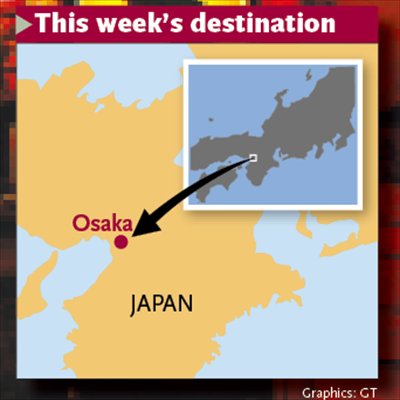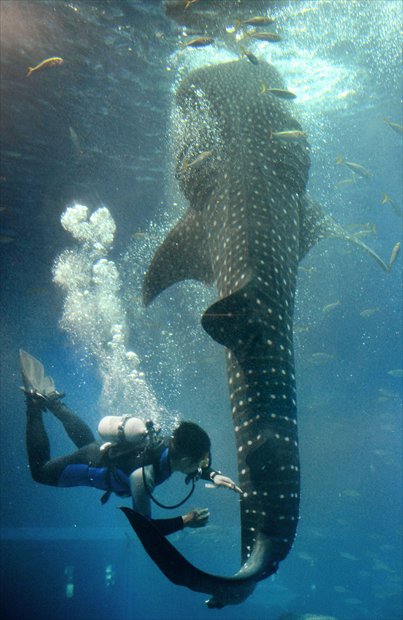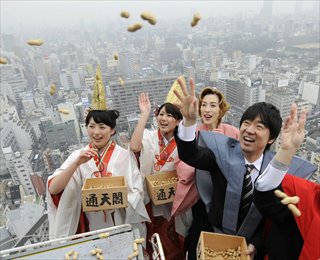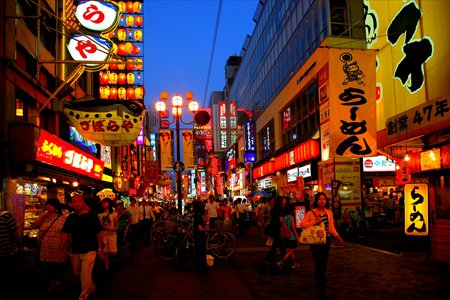Overindulge in Osaka

This week's destination

At the Osaka Aquarium (left) and atop the Tsutenkaku Tower (right) Photo: IC

At the Osaka Aquarium (left) and atop the Tsutenkaku Tower (right) Photo: IC

People walk the streets of Osaka at night. Photo: IC
Osaka isn't usually the first choice for tourists in Japan. But while the country's third-largest city, which boasts a strong economic, cultural and culinary influence, may not be as famous as Tokyo or Kyoto, it is most definitely a place that is well worth a visit.
Located in Japan's cultural and historical heartland, the Kansai region, Osaka is a local powerhouse with a history of more than 1,300 years to its name. This gives Osaka a special character that is reflected in its food and commercial prowess. Osaka is said to be more entrepreneurial and pragmatic compared to the more formal and sophisticated Tokyo, a contrast that's similar to say, Beijing and Shanghai or Melbourne and Sydney. It's near former imperial capitals like Nara and Kyoto as well as the port city of Kobe, making it an ideal gateway for travel.
Osaka's main historical attraction is Osaka Castle, an imposing reminder of medieval Japan located in the middle of a modern business district. Tall and commanding with multi-tiered roofs, the castle is surrounded by an immense moat within a large park.
As impressive as the castle is, it is a reconstruction built in 1931. The original castle was built in 1583, and was the site of an epic siege and slaughter involving samurai armies and one of Japan's famous rulers. In 1615, shogun Tokugawa Ieyasu defeated the forces of Toyotomi Hideyori, son of the great general Hideyoshi, at this castle, destroying the Toyotomi clan for good.
The castle is actually a museum about the Toyotomi and their final battle, with samurai armor, weapons and vivid battle scrolls. The top of the castle lets you look out over the park and at this stunning industrial city to visualize the stark contrast between the bloody past and the peaceful, high-tech present. The park around the castle is a popular place to view cherry blossoms in spring when people often hold hanami or blossom viewing picnics.
Peace on earth
Within this park is the Peace Osaka museum. The name gives a clue about its intention, and why it's particularly interesting is that it features open displays about Japan's past aggression in the mid-20th century, perhaps one of the few in the nation. The main exhibits focus on Japan's invasion of China and colonialism of Korea. It also features information about the bombing of Osaka by the US during World War II. It's a laudable initiative that acknowledges the nation's dark acts and promotes the idea that peace can be achieved by remembering the past, a sentiment that doesn't seem to be shared by many of its politicians and media.
Opposite the park on its southwest corner is the Osaka Museum of History, a convex-lens-shaped tower. Seven stories high, and connected to the neighboring NHK-Osaka tower, you go up to the top and work your way down each floor.
There are some fine displays including one floor devoted to ancient Osaka, though not too many actual artifacts. I learned that Osaka was actually a capital of Japan, briefly in the 7th and 8th centuries, when it was called Naniwa. To stress this fact, you can stare out from the museum at a park across the street, which was the site of a palace compound in ancient times.
One of the city's best places to eat and shop is also where you can see its most famous landmark - a giant neon sign of a runner finishing his race, the logo of Glicko, maker of snacks such as Pocky sticks. Dotombori is a street filled with big, bright signs of restaurants along a canal. The signs advertise food, consisting of crabs, cows, blowfish and even a dragon, the latter for a Chinese restaurant. Cutting directly through Dotombori is Shinsaibashi, a covered pedestrian shopping arcade - popular venues around Osaka - full of brand-name stores and boutiques.
The best place to view Osaka from up high is at Uemeda Sky Building, a structure made up of two gleaming blue 40-story towers joined at the top by an observatory on the roof. To access the observatory, you take an elevator to one of the upper floors, then ride an open-air escalator hundreds of feet above the ground.
The top offers views of the surrounding Uemeda district, Osaka's main business area, up close on one side, and on the other side, the Yodo River as it runs into Osaka Bay. The city's skyline isn't exactly breathtaking like Hong Kong or Shanghai, but there are some elegant towers. The observatory is open until nighttime and is popular among couples seeking a romantic viewing point.
Osaka has one of the world's biggest public aquariums. Popularly known as just Kaiyukan, the Osaka Aquarium, which features two whale sharks, is fittingly located near the sea. The eight-storey aquarium boasts a vast "collection" of the Pacific Rim and is divided into distinct zones. Like the history museum, start at the top. The displays are nice and the creatures varied, but it was particularly special to see the world's largest fish swimming placidly around in their large magnificence.
The aquarium is also probably one of the few places where you can see ocean sunfish, a giant fish that appears to have no tail. One of the last exhibits is a large "touching" pool where you can lean over and touch manta rays - and, even sharks. Not surprisingly, it was surrounded by happy, squealing schoolchildren on a field trip when I visited. It's not the only attraction in the vicinity either as there's also a giant Ferris wheel, a food mall, and a sailing ship modeled and named after Christopher Columbus' Santa Maria that you can take a cruise on.
Osaka doesn't have as many temples as Kyoto, but it does have the nation's first Buddhist and oldest state-administered temple. Tennoji Temple consists mainly of a five-story pagoda and a hall located in the center of a courtyard surrounded by a wall. As it is with several historical sites in Japan, it was a reconstruction of the original which was built in 593. And as with most attractions in Japan, it was very well-built and maintained - though somewhat, unsurprisingly, sterile. There are shrines, ponds, and even a graveyard in the outer grounds, which makes for a more interesting stroll.
Lasting impressions
But besides the bustling business districts, glitzy shopping areas and cool attractions, you can catch a very different side of Japan through Osaka's working-class areas.
My first impression of the city was less favorable. After catching the last train from the airport to the city center, I walked out of a foul-smelling station near my hotel after midnight to see a homeless person wandering around and a drunk man passed out on the sidewalk. This was no doubt an area hit by hard times.
Around the block, there were local equivalents of dollar stores, inexpensive clothing stores and small bars where female bartenders sang karaoke. After an initial adjustment period, however, I grew to appreciate the character of the area, whose streets were really no less clean or safe than a number of ordinary streets in Beijing or Taipei. But those lasting impressions were before - amusingly - I found out that this area was considered among the most dangerous in Japan and that even some locals were afraid to set foot in it.
The area, near Shinsekai or New World, seems ironic though it no doubt probably represented a new place when it was built. Shinsekai actually features one of Osaka's more well-known landmarks, the Tsutenkaku Tower. This is an Eiffel Tower-wannabe, which resembles a bloated airport tower, but I have to admit it looked pretty good when lit up at night. It's also a reconstruction, having been rebuilt in 1956 after the original, built in 1912, was disassembled during World War II and used for the war effort. Shinsekai is one of the older and lesser developed parts of the city, yet it's filled with restaurants and bars, and is a tourist attraction described in many guidebooks and on several websites, which contradicts its supposedly unsafe reputation. When I wandered around there one evening and safety (or rather the lack of) was never on my mind.
I'd be remiss not to mention the food since it is a big part of the city's culture. So much so, that people in Japan have a saying that goes: Kyoto folks go broke from buying too many clothes, while Osakans go broke from eating too much. However, due to factors such as traveling solo, being on a rushed schedule and not being a big fan of seafood, a staple here, I didn't get to taste many local specialties, but the udon noodles and inexpensive set meals I had were satisfying. Especially, if you're a foodie, who's crazy for Japanese cuisine, be warned to bring your appetite when you visit this truly interesting city.
Rules of Thumb
How to go: Fly direct from several Chinese cities, including Hong Kong, Beijing, Shanghai, Guangzhou, Dalian, Qingdao, or Hangzhou. You can also go by boat from Shanghai, but be warned the trip takes about two days.
When to go: Year-round travel is fine since Osaka has mild winters though it can get quite hot and humid in summer. Springtime is a pleasant time to visit as cherry blossoms bloom in March or April.
Where to stay: The Namba and Uemeda districts are among the city's liveliest areas, good for shopping, eating, and entertainment. The southern district of Shinimiya is more budget-friendly or "working-class," and is close to Shinsekai.